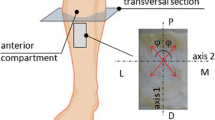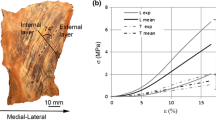Abstract
The mechanical properties of deep fasciae strongly affect muscular actions, development of pathologies, such as acute and chronic compartment syndromes, and the choice of the various fascial flaps. Actually, a clear knowledge of the mechanical characterization of these tissues still lacks. This study focuses attention on experimental tests of different regions of human crural fascia taken from an adult frozen donor. Tensile tests along proximal–distal and medial–lateral direction at a strain rate of 120 %/s were performed at the purpose of evaluating elastic properties. Viscous phenomena were investigated by applying incremental relaxation tests at total strain of 7, 9 and 11 % and observing stress decay for a time interval of 240 s. The elastic response showed that the fascia in the anterior compartment is stiffer than in the posterior compartment, both along the proximal–distal and medial–lateral directions. This result can explain why the compartment syndromes are more frequent in this compartment with respect to posterior one. Furthermore, the fascia is stiffer along the proximal–distal than along medial–lateral direction. This means that the crural fascia can adapt to the muscular variation of volume in a transversal direction, while along the main axis it could be considered as a structure that contributes to transmitting the muscular forces at a distance and connecting the different segments of the limb. The stress relaxation tests showed that the crural fascia needs 120 s to decrease stress of 40 %, suggesting a similar time also in the living so that the static stretching could have an effect on the fascia.







Similar content being viewed by others
References
Benettazzo L, Bizzego A, De Caro R, Frigo G, Guidolin D, Stecco C (2011) 3D reconstruction of the crural and thoracolumbar fasciae. Surg Radiol Anat 33:855–862. doi:10.1007/s00276-010-0757-7
Benjamin M (2009) The fascia of the limbs and back—a review. J Anat 214:1–18. doi:10.1111/j.1469-7580.2008.01011.x
Carew EO, Barber JE, Vesely I (2000) Role of preconditioning and recovery time in repeated testing of aortic valve tissues: validation through quasilinear viscoelastic theory. Ann Biomed Eng 28:1093–1100. doi:10.1114/1.1310221
Cheng S, Clarke EC, Bilston LE (2009) The effects of preconditioning strain on measured tissues properties. J Biomech 42:1360–1362. doi:10.1016/j.jbiomech.2009.03.023
Dhal M, Hansen P, Stal P, Edmundsson D, Magnusson SP (2011) Stiffness and thickness of fascia do not explain chronic exertional compartment syndrome. Clin Orthop Relat Res 469:3495–3500. doi:10.1007/s11999-011-2073-x
Einat R, Yoram L (2010) Recruitment viscoelasticity of the tendon. J Biomed Eng 43:3177–3182. doi:10.1115/1.3212107
Hurschler C, Vanderby R, Martinez DA, Vailas AC, Turnipseed WD (1994) Mechanical and biomechanical analyses of tibial compartment fascia in chronic compartment syndrome. Ann Biomed Eng 22:272–279. doi:10.1007/BF02368234
Liu Z, Yeung K (2008) The preconditioning and stress relaxation of skin tissue. J Biomed Pharm Eng 2:22–28
Simmonds N, Miller P, Gemmel H (2010) A theoretical framework for the role of fascia in manual therapy. J Bodywork Mov Ther 16:83–93. doi:10.1016/j.jbmt.2010.08.001
Stecco A, Macchi V, Masiero S, Porzionato A, Tiengo C, Stecco C, Delmas V, De Caro R (2009) Pectoral and femoral fasciae: common aspects and regional specializations. Surg Radiol Anat 31:35–42. doi:10.1007/s00276-008-0395-5
Stecco C, Pavan PG, Porzionato A, Macchi V, Lancerotto L, Carniel EL, Natali A, De Caro R (2009) Mechanics of crural fascia: from anatomy to constitutive modeling. Surg Radiol Anat 31:523–529. doi:10.1007/s00276-009-0474-2
Stecco C, Porzionato A, Lancerotto L, Stecco A, Macchi V, Day JA, De Caro R (2008) Histological of the deep fascia of the limbs. J Bodywork Mov Ther 12:225–230. doi:10.1016/j.jbmt.2008.04.041
Sverdlik A, Lanir Y (2002) Time-dependent mechanical behavior of sheep digital tendons, including the effects of preconditioning. J Biomech Eng 124:78–84. doi:10.1115/1.1427699
Turnipseed WD, Hurschler C, Vanderby R (1995) The effects of elevated compartment pressure on tibial arteriovenous flow and relationship of mechanical and biomechanical characteristics of fascia to genesis of chronic anterior compartment syndrome. J Vasc Surg 21:810–817. doi:10.1016/S0741-5214(05)80012-6
Acknowledgments
The mechanical testing instrument adopted for the development of this work was funded by CARIPARO Foundation (Italy). This support is gratefully acknowledged.
Author information
Authors and Affiliations
Corresponding author
Rights and permissions
About this article
Cite this article
Stecco, C., Pavan, P., Pachera, P. et al. Investigation of the mechanical properties of the human crural fascia and their possible clinical implications. Surg Radiol Anat 36, 25–32 (2014). https://doi.org/10.1007/s00276-013-1152-y
Received:
Accepted:
Published:
Issue Date:
DOI: https://doi.org/10.1007/s00276-013-1152-y




